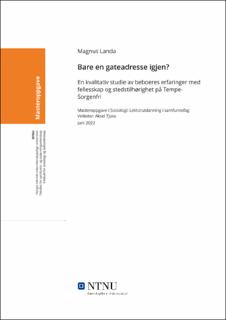| dc.contributor.advisor | Tjora, Aksel | |
| dc.contributor.author | Landa, Magnus | |
| dc.date.accessioned | 2022-07-19T17:22:56Z | |
| dc.date.available | 2022-07-19T17:22:56Z | |
| dc.date.issued | 2022 | |
| dc.identifier | no.ntnu:inspera:104661660:11334761 | |
| dc.identifier.uri | https://hdl.handle.net/11250/3007048 | |
| dc.description.abstract | Denne masteroppgaven tar for seg hvordan beboere i bydelen Tempe-Sorgenfri i Trondheim opplever og erfarer fellesskap, samhold og tilhørighet til bydelen. Med bakgrunn i min fenomenologiske og interaksjonistiske forskningsposisjon har jeg gjennomført kvalitative dybdeintervjuer med ni beboere i bydelen. Den sosiologiske analysen av bydelen har gitt meg mulighet til å diskutere hvordan fellesskap og stedstilhørighet som mekanismer kan forstås, og mer konkret (1) det fysiske miljøets betydning for fellesskap og stedstilhørighet, (2) ulike reaksjoner mot nærmiljøets stigmatisering og (3) forholdet mellom et innenfra- og utenfraperspektiv.
Studiens empiriske funn avdekker hvordan Tempe-Sorgenfri som bydel preges av lite aktivitet, få møteplasser, lite fellesskap og lav stedstilhørighet. I forlengelsen av dette diskuterer jeg den lave stedstilhørigheten i lys av bydelens store leieandel og fysiske fasiliteter. Flere beboere ser på bostedet som en midlertidig mellomstasjon som følge av leieforhold, og nærmiljøets fysiske miljø virker mer som en barriere enn en tilrettelegger for sosial aktivitet. Konsekvensen er at mange beboere har lav motivasjon til å utvise engasjement og deltakelse i lokalmiljøet, noe som gjør det utfordrende å skape et sterkt fellesskap. Selv om jeg støtter meg på et bredt spekter av teoretiske perspektiver vil jeg fremheve hvordan Wacquant (2008) med begrepet territoriell stigmatisering og Henriksen og Tjora (2014) med begrepet interaksjonspåskudd har vært spesielt sentrale i analysen av oppgavens empiriske grunnlag.
I en videreføring av å svare på oppgavens problemstilling og forskningsspørsmål presenterer jeg en ambisjon om konseptuell generalisering, om hvordan oppgaven er samfunnsmessig relevant utover min enkelte case. Resultatet er utviklingen av en typologisering tilknyttet hvordan beboeres reaksjoner på bydelens stigmatisering kan kategoriseres i tre ulike posisjoner: den likegyldige, den fornærmede og den motstandsdyktige. Hvordan en beboer reagerer på områdets nedvurdering avhenger av grad av stedstilhørighet, tidsperspektiv på bosted og grad av uformelle og formelle relasjoner. Konseptet er et resultat av et fruktbart samspill mellom masteroppgavens eget datagrunnlag, teoretiske perspektiver og tidligere forskning. | |
| dc.description.abstract | This study deals with how inhabitants at Tempe-Sorgenfri in Trondheim experience fellowship, togetherness and affiliation towards their neighbourhood. Based on my phenomenological and interactionist research position, I have conducted qualitative in-depth interviews with nine inhabitants in the district. The sociological analysis of the district has given me the opportunity to discuss how mechanisms such as fellowship and affiliation can be understood, and more specifically (1) the physical environment’s importance for fellowship and affiliation, (2) different reactions towards the stigmatization of the local community and (3) the relationship between an inside and outside perspective.
The study’s empirical findings reveal how Tempe-Sorgenfri as a district suffers of a low level of activity, few meeting places, low sense of fellowship and a low degree of affiliation. In the extension of this, I discuss the low affiliation in light of the district’s high leasehold and physical facilities. Multiple inhabitants view their living place as a temporary stopover, and the local district’s physical environment seems more like a barrier than a facilitator for social activity. The consequence is that the inhabitants experience a low degree of motivation to show commitment and participation in the local community, which makes it challenging to create a strong fellowship. Although I rely on a large range of theoretical perspectives, I want to highlight how Wacquant (2008) with the concept of territorial stigmatization and Henriksen and Tjora (2014) with the concept of interaction pretexts have been particularly central in the analysis of the thesis’ empirical findings.
In a continuation of answering the thesis’ research questions, I present an ambition of conceptual generalization, about how the thesis is relevant to the society beyond my individual case. The result is a development of a typology associated with how inhabitants’ reactions to the district’s stigmatization can be categorized into three different positions: the indifferent, the offended and the resistant. How an inhabitant reacts to the district’s stigmatization, depends on the degree of affiliation, time perspective on place of residence and the size of their social network. The concept is a result of an interplay between the master thesis’ own empirical database, theoretical perspectives and previous research in the field. | |
| dc.language | nob | |
| dc.publisher | NTNU | |
| dc.title | Bare en gateadresse igjen? | |
| dc.type | Master thesis | |
